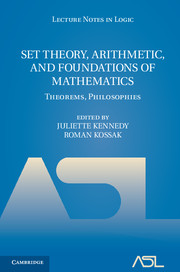Book contents
- Frontmatter
- Contents
- Introduction
- Historical remarks on Suslin's problem
- The continuum hypothesis, the generic-multiverse of sets, and the Ω conjecture
- ω-models of finite set theory
- Tennenbaum's theorem for models of arithmetic
- Hierarchies of subsystems of weak arithmetic
- Diophantine correct open induction
- Tennenbaum's theorem and recursive reducts
- History of constructivism in the 20th century
- A very short history of ultrafinitism
- Sue Toledo's notes of her conversations with Gödel in 1972–5
- Stanley Tennenbaum's Socrates
- Tennenbaum's proof of the irrationality of √2
- References
The continuum hypothesis, the generic-multiverse of sets, and the Ω conjecture
Published online by Cambridge University Press: 07 October 2011
- Frontmatter
- Contents
- Introduction
- Historical remarks on Suslin's problem
- The continuum hypothesis, the generic-multiverse of sets, and the Ω conjecture
- ω-models of finite set theory
- Tennenbaum's theorem for models of arithmetic
- Hierarchies of subsystems of weak arithmetic
- Diophantine correct open induction
- Tennenbaum's theorem and recursive reducts
- History of constructivism in the 20th century
- A very short history of ultrafinitism
- Sue Toledo's notes of her conversations with Gödel in 1972–5
- Stanley Tennenbaum's Socrates
- Tennenbaum's proof of the irrationality of √2
- References
Summary
§1. A tale of two problems. The formal independence of Cantor' Continuum Hypothesis from the axioms of Set Theory (ZFC) is an immediate corollary of the following two theorems where the statement of the Cohen's theorem is recast in the more modern formulation of the Boolean valued universe.
Theorem 1 (Gödel, [3]). Assume V = L. Then the Continuum Hypothesis holds.
Theorem 2 (Cohen, [1]). There exists a complete Boolean algebra, B, such that
VB ⊨ “The Continuum Hypothesis is false”.
Is this really evidence (as is often cited) that the Continuum Hypothesis has no answer?
Another prominent problem from the early 20th century concerns the projective sets, [8]; these are the subsets of ℝn which are generated from the closed sets in finitely many steps taking images by continuous functions, f : ℝn → ℝn, and complements. A function, f : ℝ → ℝ, is projective if the graph of f is a projective subset of ℝ × ℝ. Let Projective Uniformization be the assertion:
For each projective set A ⊂ ℝ × ℝ there exists a projective function, f : ℝ → ℝ, such that for all x ∈ ℝ if there exists y ∈ ℝ such that (x, y) ∈ A then (x, f(x)) ∈ A.
The two theorems above concerning the Continuum Hypothesis have versions for Projective Uniformization. Curiously the Boolean algebra for Cohen's theorem is the same in both cases, but in case of the problem of Projective Uniformization an additional hypothesis on V is necessary. While Cohen did not explicitly note the failure of Projective Uniformization, it is arguably implicit in his results.
- Type
- Chapter
- Information
- Set Theory, Arithmetic, and Foundations of MathematicsTheorems, Philosophies, pp. 13 - 42Publisher: Cambridge University PressPrint publication year: 2011
References
- 18
- Cited by



